- Our College
- Academics
- Student Services
- Public Reports
- Forum
- Library
- Quick Access
At the completion of Computer Information System Program the student will be able to:
CIS_PSLO_1. Demonstrate an in-depth understanding of technical concepts and ethical issues pertaining to information systems;
CIS_PSLO_2. Demonstrate theoretical knowledge and practical skills in the management and strategic use of information systems and technology;
CIS_PSLO_3. Demonstrate proficiency in the use of different software applications significant to manipulating and analyzing information as well as generating and presenting reports in the various functional areas of business;
CIS_PSLO_4. Demonstrate solid foundation skills in database design and management, web engineering, programming, and networking; and
CIS_PSLO_5. Demonstrate the ability to adapt to latest technologies using their foundation knowledge and skills from CIS.
PSLO Assessment Report Summary
The Division of Business Administration posted the Associate of Science in Computer Information Systems (CIS) program assessment plan in TracDat for assessment cycle 2016-2017. The CIS program assessed CIS_PSLO_3, student should be able to demonstrate proficiency in the use of different software applications significant to manipulating and analyzing information as well as generating and presenting reports in the various functional areas of business, and CIS_PSLO_5, student should be able to demonstrate the ability to adapt to latest technologies using their foundation knowledge and skills from CIS.
During the assessment period, the improvement plans listed in assessment cycle 2014-2015 were implemented. In CIS Program Student Learning Outcome 3 (CIS_PSLO_), the CIS program helped students develop competency with resources – course materials, technology and time. Program faculty emphasized planning skills in relation to preparing, working, and completing case projects. Similar case study were given with clear directions and improve the grading rubric. In CIS Program Student Learning Outcome 5 (CIS_PSLO_5), the CIS program helped students to think critically so they may adjust to change. Program faculty seek opportunities for students to stretch their minds, find new answers, ask hard questions, and lay the foundation for lifelong learning.
The CIS program targeted at least sixty percent (60%) of students should meet at least a BENCHMARK level of performance based on grading rubric1 (See Table A1) as measured by individual hands-on project. The assessment of CIS_PSLO_3 used CA105 Data Analysis and IS230 Database Design Management’s embedded assessment strategies to demonstrate proficiency in the use of different software applications significant to manipulating and analyzing information as well as generating and presenting reports in the various functional areas of business (see Table A2). The assessment of CIS_PSLO_5 used IS245 Desktop Publishing and IS260 Business Information Systems’ embedded assessment strategies to demonstrate the ability to adapt to latest technologies using their foundation knowledge and skills from CIS(see Table A2). Collection of data was done during fall 2016 and spring 2017 period.
| CRITERIA | Capstone (4) | Milestones (3-2) | Benchmark (1) | Below Benchmark (0) |
| Initiative | Completes required work, generates and pursues opportunities to expand knowledge, skills, and abilities |
Completes required work, identifies and pursues opportunities to expand knowledge, skills, and abilities |
Completes required work and identifies opportunities to expand knowledge, skills, and abilities |
Incompletes required work |
| Transfer | Makes explicit references to previous learning and applies in an innovative (new and creative) way that knowledge and those skills to demonstrate comprehension and performance in novel situations. |
Makes references to previous learning and attempts to apply that knowledge and those skills to demonstrate comprehension and performance in novel situations |
Makes vague references to previous learning but does not apply knowledge and skills to demonstrate comprehension and performance in novel situation |
No references to previous learning and does not apply knowledge and skills to demonstrate comprehension and performance in novel situation |
| ASSESSED CIS PSLO NUMBER |
MAPPED COURSES | CSLO NUMBER |
| CIS_PSLO_3 | IS230 – Database Design | IS230_CSLO_4 |
| CA105 – Data Analysis | CA105_CSLO_3 | |
| CIS_PSLO_5 | IS245 – Desktop Publishing | IS245_CSLO_3 |
| IS260 – Business Info System | IS260_CSLO_3 |
The assessment results of CIS_PSLO_3 based on the grading rubric, ninety-two percent (92%) or 33 out of 36 students met at least or above benchmark and eight percent (8%) or 3 out of 36 students were below the benchmark during fall 2016 assessment period(see Chart A1). One-hundred percent (100%) or 31 out of 31 students met at least or above the benchmark level of performance during spring2017 assessment period (see Chart A1).
Chart A1During fall 2016 period, Chart A2 shows the embedded assessment results of mapped course - Database Design(IS230_CSLO_4) with fifty-eight percent (58%) or 11 out of 19 students rated above benchmark level of performance and forty-two percent (42%) or 8 out of 19 students rated benchmark level of performance, and the embedded assessment results of mapped course - Data Analysis (CA105_CSLO_3) with eighty-three percent(83%) or 19 out of 22 students rated above benchmark level of performance and seventeen percent (17%) or 4 out of 22 students rated benchmark level of performance.(see Chart A2).
Chart A2During spring 2017 period, chart A3 shows the embedded assessment results of mapped course - Database Design(IS230_CSLO_4) with eighty-six percent (86%) or 11 out of 19 students rated above benchmark level of performance and fourteen percent (14%) or 3 out of 22 students rated benchmark level of performance. The embedded assessment results of mapped course - Data Analysis (CA105_CSLO_3) with one-hundred percent(100%) or 22 out of 22 students rated above benchmark level of performance (see Chart A3).
Chart A3The assessment results of CIS_PSLO_5 based on the grading rubric, one-hundred percent (100%) or 21 out of 21 students met at least or above benchmark during fall 2016(see Chart B1). Ninety-six percent (96%) or 24 out of 25 students meet at least or above the benchmark and four percent (4%) or 1 out of 25 students was below benchmark during spring2017(see Chart B1).
Chart B1During fall 2016 period, Chart B2 shows the embedded assessment results of mapped course - Business Information Systems(BU260_CSLO_3) with twenty-six percent (26%) or 5 out of 19 students rated above benchmark level of performance and seventy-four percent (74%) or 14 out of 19 students rated benchmark level of performance. The embedded assessment results of mapped course - Desktop Publishing(IS245_CSLO_3) with one-hundred percent (100%) or 19 out of 19 students rated above benchmark level of performance (see Chart B2).
Chart B2During spring 2017 period, Chart B3 shows the embedded assessment results of mapped course - Business Information Systems(BU260_CSLO_3) with ninety-five percent (95%) or 19 out of 20 students rated above benchmark level of performance and five percent (5%) or 1 out of 20 students rated below benchmark level of performance. The embedded assessment results of mapped course - Desktop Publishing(IS245_CSLO_3) with one-hundred percent (100%) or 19 out of 19 students rated above benchmark level of performance (see Chart B3).
Chart B3AP Full Official:Associate of Science in Computer Information Systems
Campus: National Campus
Completed by: Business Division
AP Review Submission Date: March 28th, 2014
AR Review Cycle: Fall 2011 – Fall 2013
Associate of Science in Computer Information Systems provides students with a solid foundation in theory and practice of the computer information systems and prepare them to meet the immediate job market needs, adapt themselves to the rapidly evolving computer industry and further their education in a higher degree program. This contributes to the college’s mission of assisting in the development of the Federated States of Micronesia, and to be globally connected.
In today’s world, information is a very vital resource in an organization. In order to efficiently utilize information of any form in an organization however, this has to be processed within the organization. This is where information technology with its varied tools becomes very indispensable.
In the Federated States of Micronesia, however humble its beginning might be, it is imperative that this information technology, coupled with communications has to be taught and learned in the lone college so that the people can be educated and organizations can adapt to, and gradually become at pace with the world trend. With this necessity, the semester of Fall 1998 saw the emergence of a new academic program offering at COM-FSM’s Business Division, the Associate of Science Degree in Computer Information Systems.
The Associate of Science in Computer Information Systems program concentrates on organizational applications of information and communications technology and the development of systems and their management. Students receive a fundamental understanding of programming, web engineering, database designing and networking, which prepare them for high-in-demand careers such as programmers, webmasters, network administrators, systems analysts, etc.
Applicants must meet the following admission requirements to be matriculated into this degree program:
Degree Requirements Summary
Degree Requirements in Detail
| Preparatory Courses – By Placement
General Education Core courses English (9 credits) Mathematics (3 credits) Natural Sciences (7 credits) Computer Applications (3 credits) Exercise Sports Science (1 credit) Humanities (3 credits) |
CIS Major Courses Information Systems (20 credits) Business (7 credits) Communications (3 credits) Mathematics (6 credits) Electives: Any two of the following courses (6 credits) |
| Course | No. of Sections | Course Enrollment | Section Fill Rate | Redundancy |
| Fall 2011-Fall 2013 | ||||
| IS 201 Computer Info. Systems | 2 | 277 | 92.33% | no |
| IS 220 Computer Programming | 2 | 164 | 99.39% | no |
| IS 230 Database Design | 1 | 148 | 98.67% | no |
| IS 240 Web page Design | 1 | 150 | 100% | no |
| IS 245 Desktop Publishing | 1 | 81 | 108% | no |
| IS 260 Business Info. Systems | 1 | 117 | 78.00% | no |
| IS 280 Intro to Networking | 2 | 123 | 102.50% | no |
| CA 105 Data Analysis | 1 | 161 | 107.33% | no |
| JOSEPH FELIX, JR, Associate Professor Bachelor of Science in Computer Science (Park College, Missouri) Master of Science in Information Systems (National University, California) |
MARLENE MANGONON, Associate Professor Bachelor in Computer Data Processing Management (Polytechnic University of the Philippines, Philippines) Master in Business Administration (Virgen Milagrosa University, Philippines |
| EDPER CASTRO, Assistant Professor Bachelor of Science in Information and Computer Science (Cebu Institute of Technology, Philippines) Diploma in Computer Science (Open University, University of the Philippines, Philippines) Masters in Information Systems (Open University, University of the Philippines, Philippines) |
George Mangonon, Assistant Professor Bachelor of Science in Mathematics (University of the Philippines, Philippines) Master in Business Administration (Virgen Milagrosa University, Philippines), Doctorate in Business Administration (sans Dissertation) (Virgen Milagrosa University, Philippines), IT Background: Programming - COBOL and Visual Basic (Systems Technology Institute, Philippines and Informatics, Philippines) |
| Year | Spring | Spring Raio | Fall | Fall Ratio |
| 2011 | 172 | 1:57 | 198 | 1:66 |
| 2012 | 177 | 1:59 | 211 | 1:52 |
| 2013 | 173 | 1:43 | 160 | 1:40 |
| Assessment of course student learning outcomes of program courses | IS201-Computer Information Systems
Success Rate for SLO
CA105-Data Analysis Success Rate for SLO
IS220-Computer Programming Success Rate for SLO
IS240-Webpage Design Success Rate for SLO
IS230-Database Design Success Rate for SLO
IS245-Desktop Publishing Success Rate for SLO
IS260-Business Information Systems Success Rate for SLO
IS280-Introduction to Networking Success Rate for SLO
|
||||||||||||||||||||||||||||||||||||||||||||||||||||||||||||||||||||||||||||||||||||||||||||||||||||||||||||||||||||||||||||||||||||||||||||||||||||||||||||||||||||||||||||||||||||||||||||||||||||||||||||||||||||||||||||||||||||||||||||||||||||||||||||||||||||||||||||||||||||||||||||||||||||||||||||||||||||||||||||||||||||||||||||||||||||||||||||||||||||||||||||||||||||||||||||||||||||||||||||||||||||||||||||||||||||||||||||||||||||||||||||||||||||||||||||||||||||||||||
| Assessment of program student learning outcomes | 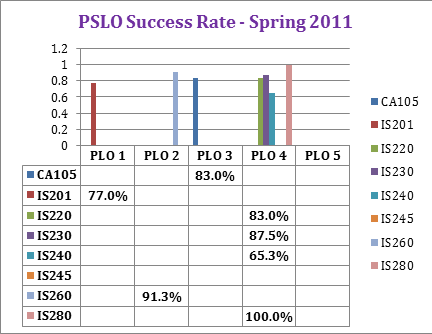
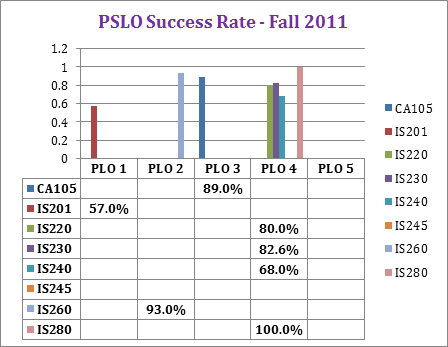
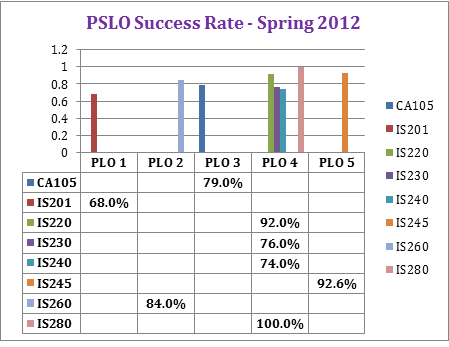
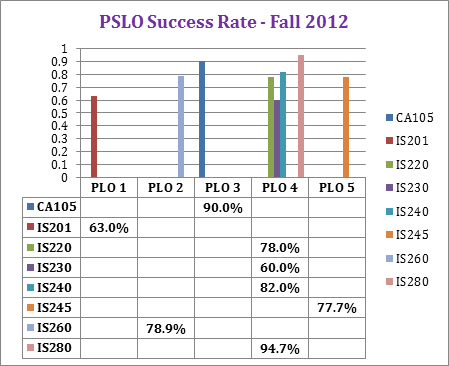
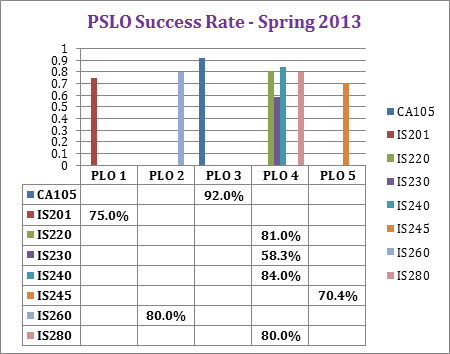
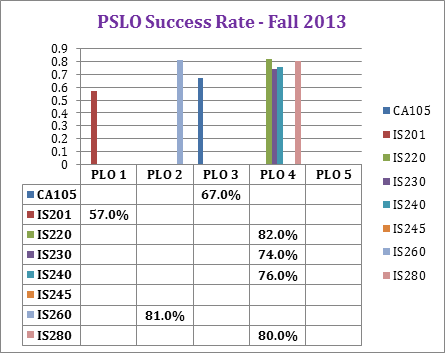 |
||||||||||||||||||||||||||||||||||||||||||||||||||||||||||||||||||||||||||||||||||||||||||||||||||||||||||||||||||||||||||||||||||||||||||||||||||||||||||||||||||||||||||||||||||||||||||||||||||||||||||||||||||||||||||||||||||||||||||||||||||||||||||||||||||||||||||||||||||||||||||||||||||||||||||||||||||||||||||||||||||||||||||||||||||||||||||||||||||||||||||||||||||||||||||||||||||||||||||||||||||||||||||||||||||||||||||||||||||||||||||||||||||||||||||||||||||||||||||
| Program enrollment (historical enrollment patterns, student credits by major) |
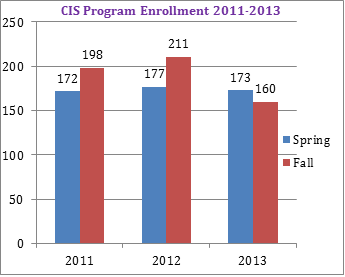
All Program Enrollment 2011-2013
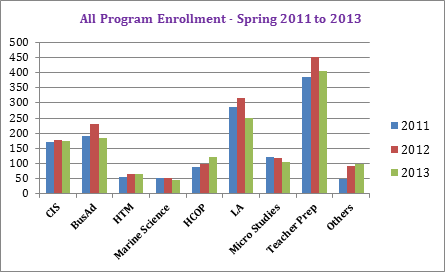
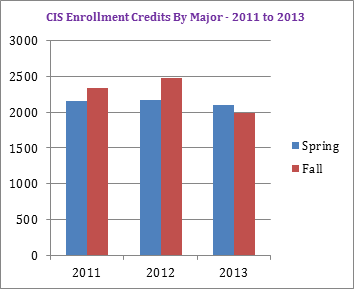
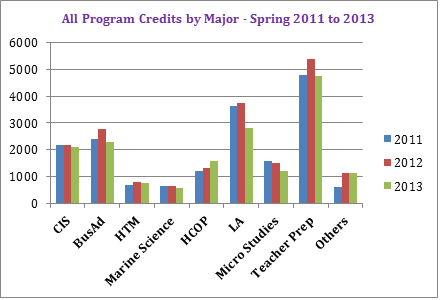
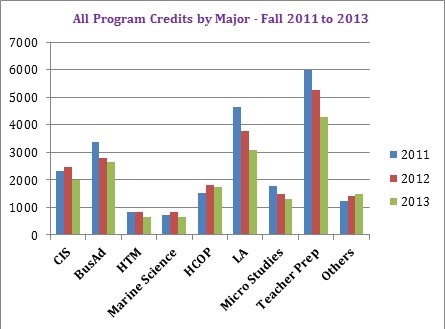
|
||||||||||||||||||||||||||||||||||||||||||||||||||||||||||||||||||||||||||||||||||||||||||||||||||||||||||||||||||||||||||||||||||||||||||||||||||||||||||||||||||||||||||||||||||||||||||||||||||||||||||||||||||||||||||||||||||||||||||||||||||||||||||||||||||||||||||||||||||||||||||||||||||||||||||||||||||||||||||||||||||||||||||||||||||||||||||||||||||||||||||||||||||||||||||||||||||||||||||||||||||||||||||||||||||||||||||||||||||||||||||||||||||||||||||||||||||||||||||
| Average class size |
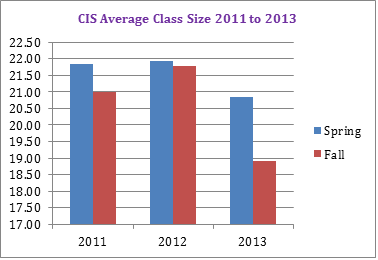
All Program Average Class Size Spring 2011 to 2013
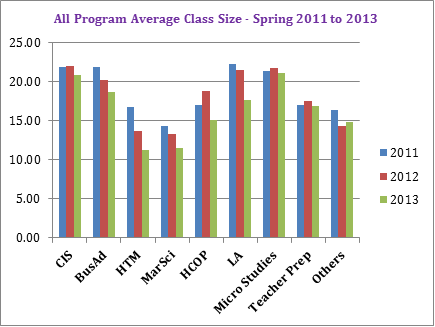
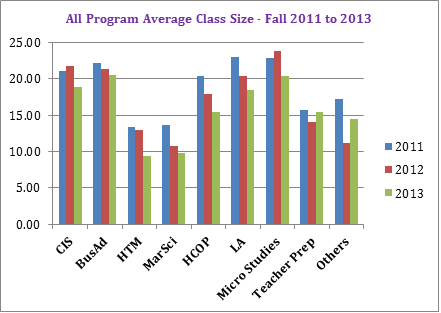
|
||||||||||||||||||||||||||||||||||||||||||||||||||||||||||||||||||||||||||||||||||||||||||||||||||||||||||||||||||||||||||||||||||||||||||||||||||||||||||||||||||||||||||||||||||||||||||||||||||||||||||||||||||||||||||||||||||||||||||||||||||||||||||||||||||||||||||||||||||||||||||||||||||||||||||||||||||||||||||||||||||||||||||||||||||||||||||||||||||||||||||||||||||||||||||||||||||||||||||||||||||||||||||||||||||||||||||||||||||||||||||||||||||||||||||||||||||||||||||
| Course completion rate |
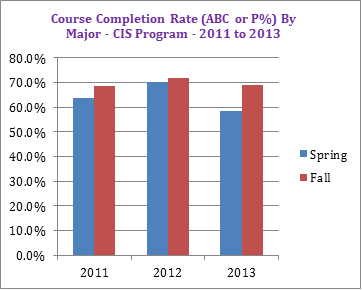
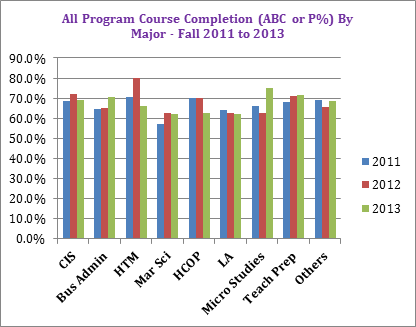
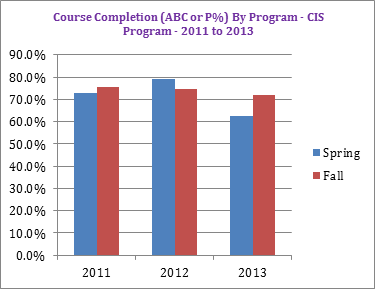
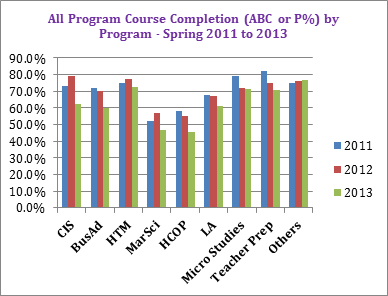
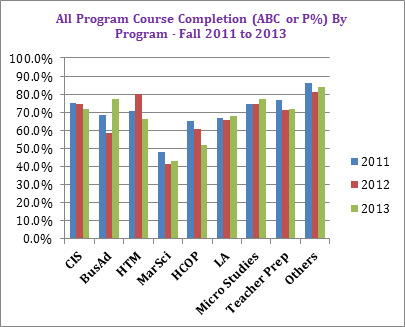
| ||||||||||||||||||||||||||||||||||||||||||||||||||||||||||||||||||||||||||||||||||||||||||||||||||||||||||||||||||||||||||||||||||||||||||||||||||||||||||||||||||||||||||||||||||||||||||||||||||||||||||||||||||||||||||||||||||||||||||||||||||||||||||||||||||||||||||||||||||||||||||||||||||||||||||||||||||||||||||||||||||||||||||||||||||||||||||||||||||||||||||||||||||||||||||||||||||||||||||||||||||||||||||||||||||||||||||||||||||||||||||||||||||||||||||||||||||||||||||
| Student persistence rate (semester to semester) |
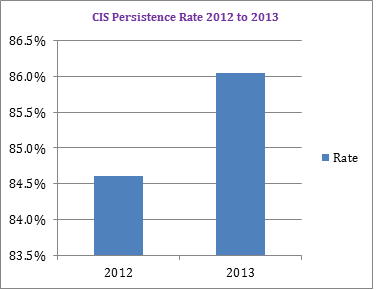
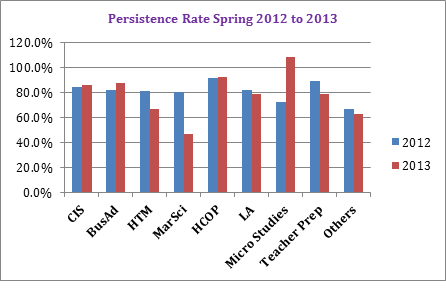
|
||||||||||||||||||||||||||||||||||||||||||||||||||||||||||||||||||||||||||||||||||||||||||||||||||||||||||||||||||||||||||||||||||||||||||||||||||||||||||||||||||||||||||||||||||||||||||||||||||||||||||||||||||||||||||||||||||||||||||||||||||||||||||||||||||||||||||||||||||||||||||||||||||||||||||||||||||||||||||||||||||||||||||||||||||||||||||||||||||||||||||||||||||||||||||||||||||||||||||||||||||||||||||||||||||||||||||||||||||||||||||||||||||||||||||||||||||||||||||
| Student retention rate (Fall-to-Fall for two-year programs; Fall-to-Spring for one-year programs) |
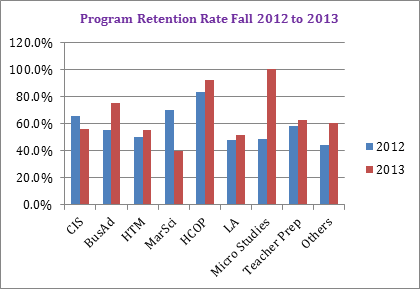
|
||||||||||||||||||||||||||||||||||||||||||||||||||||||||||||||||||||||||||||||||||||||||||||||||||||||||||||||||||||||||||||||||||||||||||||||||||||||||||||||||||||||||||||||||||||||||||||||||||||||||||||||||||||||||||||||||||||||||||||||||||||||||||||||||||||||||||||||||||||||||||||||||||||||||||||||||||||||||||||||||||||||||||||||||||||||||||||||||||||||||||||||||||||||||||||||||||||||||||||||||||||||||||||||||||||||||||||||||||||||||||||||||||||||||||||||||||||||||||
| Success rates on licensing or certification exams (CTE, TP, Nursing, etc) | NONE | ||||||||||||||||||||||||||||||||||||||||||||||||||||||||||||||||||||||||||||||||||||||||||||||||||||||||||||||||||||||||||||||||||||||||||||||||||||||||||||||||||||||||||||||||||||||||||||||||||||||||||||||||||||||||||||||||||||||||||||||||||||||||||||||||||||||||||||||||||||||||||||||||||||||||||||||||||||||||||||||||||||||||||||||||||||||||||||||||||||||||||||||||||||||||||||||||||||||||||||||||||||||||||||||||||||||||||||||||||||||||||||||||||||||||||||||||||||||||||
| Graduation rate based on yearly number |
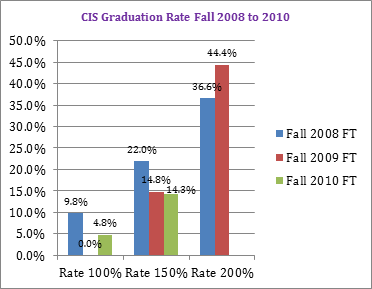
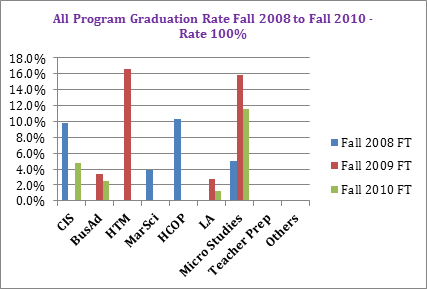
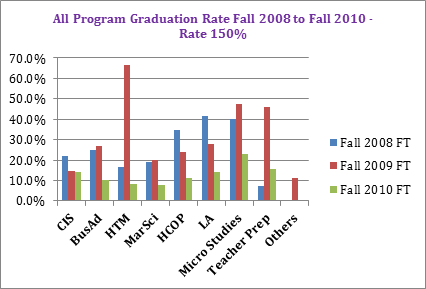
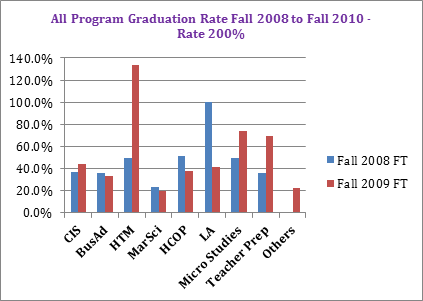
|
||||||||||||||||||||||||||||||||||||||||||||||||||||||||||||||||||||||||||||||||||||||||||||||||||||||||||||||||||||||||||||||||||||||||||||||||||||||||||||||||||||||||||||||||||||||||||||||||||||||||||||||||||||||||||||||||||||||||||||||||||||||||||||||||||||||||||||||||||||||||||||||||||||||||||||||||||||||||||||||||||||||||||||||||||||||||||||||||||||||||||||||||||||||||||||||||||||||||||||||||||||||||||||||||||||||||||||||||||||||||||||||||||||||||||||||||||||||||||
| Students seat cost | Not Available | ||||||||||||||||||||||||||||||||||||||||||||||||||||||||||||||||||||||||||||||||||||||||||||||||||||||||||||||||||||||||||||||||||||||||||||||||||||||||||||||||||||||||||||||||||||||||||||||||||||||||||||||||||||||||||||||||||||||||||||||||||||||||||||||||||||||||||||||||||||||||||||||||||||||||||||||||||||||||||||||||||||||||||||||||||||||||||||||||||||||||||||||||||||||||||||||||||||||||||||||||||||||||||||||||||||||||||||||||||||||||||||||||||||||||||||||||||||||||||
| Cost of duplicate or redundant courses, programs or services | No redundant courses therefore zero cost. | ||||||||||||||||||||||||||||||||||||||||||||||||||||||||||||||||||||||||||||||||||||||||||||||||||||||||||||||||||||||||||||||||||||||||||||||||||||||||||||||||||||||||||||||||||||||||||||||||||||||||||||||||||||||||||||||||||||||||||||||||||||||||||||||||||||||||||||||||||||||||||||||||||||||||||||||||||||||||||||||||||||||||||||||||||||||||||||||||||||||||||||||||||||||||||||||||||||||||||||||||||||||||||||||||||||||||||||||||||||||||||||||||||||||||||||||||||||||||||
| Students’ satisfaction rate | Not Available | ||||||||||||||||||||||||||||||||||||||||||||||||||||||||||||||||||||||||||||||||||||||||||||||||||||||||||||||||||||||||||||||||||||||||||||||||||||||||||||||||||||||||||||||||||||||||||||||||||||||||||||||||||||||||||||||||||||||||||||||||||||||||||||||||||||||||||||||||||||||||||||||||||||||||||||||||||||||||||||||||||||||||||||||||||||||||||||||||||||||||||||||||||||||||||||||||||||||||||||||||||||||||||||||||||||||||||||||||||||||||||||||||||||||||||||||||||||||||||
| Alumni data | Not Available | ||||||||||||||||||||||||||||||||||||||||||||||||||||||||||||||||||||||||||||||||||||||||||||||||||||||||||||||||||||||||||||||||||||||||||||||||||||||||||||||||||||||||||||||||||||||||||||||||||||||||||||||||||||||||||||||||||||||||||||||||||||||||||||||||||||||||||||||||||||||||||||||||||||||||||||||||||||||||||||||||||||||||||||||||||||||||||||||||||||||||||||||||||||||||||||||||||||||||||||||||||||||||||||||||||||||||||||||||||||||||||||||||||||||||||||||||||||||||||
| Employment data and employer feedback (employer survey) | Not Available | ||||||||||||||||||||||||||||||||||||||||||||||||||||||||||||||||||||||||||||||||||||||||||||||||||||||||||||||||||||||||||||||||||||||||||||||||||||||||||||||||||||||||||||||||||||||||||||||||||||||||||||||||||||||||||||||||||||||||||||||||||||||||||||||||||||||||||||||||||||||||||||||||||||||||||||||||||||||||||||||||||||||||||||||||||||||||||||||||||||||||||||||||||||||||||||||||||||||||||||||||||||||||||||||||||||||||||||||||||||||||||||||||||||||||||||||||||||||||||
| Program added or cancelled at nearby regional institutions (PCC, GCC, Hawaii schools, UOG, CMI, NMC) | Not Applicable | ||||||||||||||||||||||||||||||||||||||||||||||||||||||||||||||||||||||||||||||||||||||||||||||||||||||||||||||||||||||||||||||||||||||||||||||||||||||||||||||||||||||||||||||||||||||||||||||||||||||||||||||||||||||||||||||||||||||||||||||||||||||||||||||||||||||||||||||||||||||||||||||||||||||||||||||||||||||||||||||||||||||||||||||||||||||||||||||||||||||||||||||||||||||||||||||||||||||||||||||||||||||||||||||||||||||||||||||||||||||||||||||||||||||||||||||||||||||||||
| Transfer rate | Not Available | ||||||||||||||||||||||||||||||||||||||||||||||||||||||||||||||||||||||||||||||||||||||||||||||||||||||||||||||||||||||||||||||||||||||||||||||||||||||||||||||||||||||||||||||||||||||||||||||||||||||||||||||||||||||||||||||||||||||||||||||||||||||||||||||||||||||||||||||||||||||||||||||||||||||||||||||||||||||||||||||||||||||||||||||||||||||||||||||||||||||||||||||||||||||||||||||||||||||||||||||||||||||||||||||||||||||||||||||||||||||||||||||||||||||||||||||||||||||||||
| Course | Findings |
| IS201 | Low success rate of SLO#1 is due to transition from High-School classes to College-level classes because as the classes progresses or more particularly from SLO#2 and up success rate are relatively compared to SLO#1. |
| IS220 |
|
| IS23 | Students have difficulty in constructing queries (SQL - Structured Query Language) as a demonstration of proficiency for SLO#4 using mathematical expressions, relational expressions and Boolean expressions. |
| IS240 |
|
| IS245 | Course has a lot of hands-on activities and therefore activities are hands-on intensive in the form of hands-on exercises and capstone projects. Thus students who do not complete the required exercises and projects fails. |
| IS260 | |
| IS280 | In SLO #5 requires basic mathematical skills that includes analysis and quantitative reasoning for doing IP Addressing and most of students were doing poorly in this SLO. |
| CA105 | Students are doing very well in hands-on activities while they are doing poorly on the concepts and theories. The grading practice is that percentages in grading both concepts/theories and hands-on are both 50%. |
| Course | Recommendations |
| IS201 | The instructor will pay extra attention to each student for the first 4 weeks so as to gear them up to college-level thinking from high-school level thinking in terms of doing their assignments and exercises. Activities also will be crafted in such a way that it will not be more grade driven but rather it would be more value driven. For example each student will be given the same exact points in their research and subsequent reporting regardless if the reports are good or bad. However, those reports that are excellent will be given extra points that would be carried on to their succeeding exercises on the next phase of the class. |
| IS220 |
|
| IS230 | Add MS 100 with a grade of 'C' or higher as pre-requisite |
| IS240 |
|
| IS245 | Give early warning to those who habitually failed to complete exercises |
| IS260 | Strict implementation of pre-requisite of the course |
| IS280 | Ad d MS 100 as pre-requisite |
| CA105 | Increase percentage grading on the concepts and theories to 60% and decrease percentage grading on hands-on to 40%. This will not improve their grades overall but improve their learning on the concepts and theories |
This website and all COM-FSM Internet based services are best viewed with Firefox 3.0 or better.
© Copyright 2020 College of Micronesia-FSM | Site Disclaimer
P. O. Box 159, Kolonia, Pohnpei, 96941 - (691) 320-2480
College of Micronesia-FSM is accredited by the Accrediting Commission for Community and Junior Colleges,
Western Association of Schools and Colleges, 428 J Street., Suite 400 Sacramento, CA 95814, (415) 506-0234,
an institutional accrediting body recognized by the Council for Higher Education Accreditation and the U.S. Department of Education.
Additional information about accreditation, including the filing of complaints against member institutions, can be found at: www.accjc.org